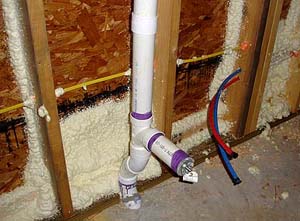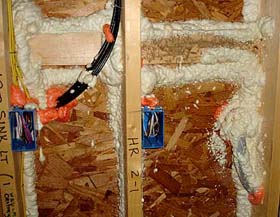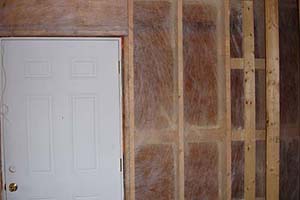|
Insulation:
|
|
|
The
first step in our
insulation process
was to use the froth
pack from Dow Chemical
to seal where the
OSB meets the studs
to eliminate air and
insect penetration.
|

Extra insulation was sprayed behind plumbing pipes on exterior walls to reduce the risk of freezing. |
|
The next step was the blown in insulation. Since it is winter time, it would have required several weeks for wet blown-in insulation to dry thoroughly to avoid mold issues before installing sheetrock. Therefore, Carolina Insulation recommended we use Blown-In Dry Pack Cellulose insulation.
|
First they applied a netting along all the exterior walls to hold the insulation in place, and then using a tube pumped the dry pack cellulose into the spaces.
|
| Blown-in
cellulose insulation
is non-toxic and extremely
energy efficient with
an R rating of 3.5-4.0/inch.
This dry cellulose is
made primarily from
recycled materials treated
with a fire retardant
as well as boric acid
to deter insects. Code requires R-15 in walls, but these insulation techniques combined with the brick, and ¾" sheetrock is giving us an 11 ½" exterior wall, for an R-Value of R-19.5-R.22 just in insulation, this doesn't count the added thermal dynamics due to the froth pack sealing out drafts along with the superior draft control of cellulose. |
|
|
Building partners:
|
|


